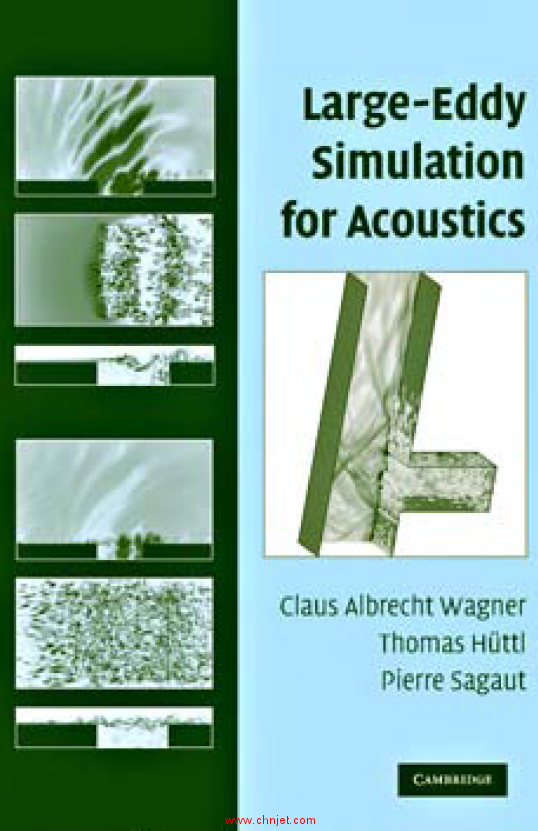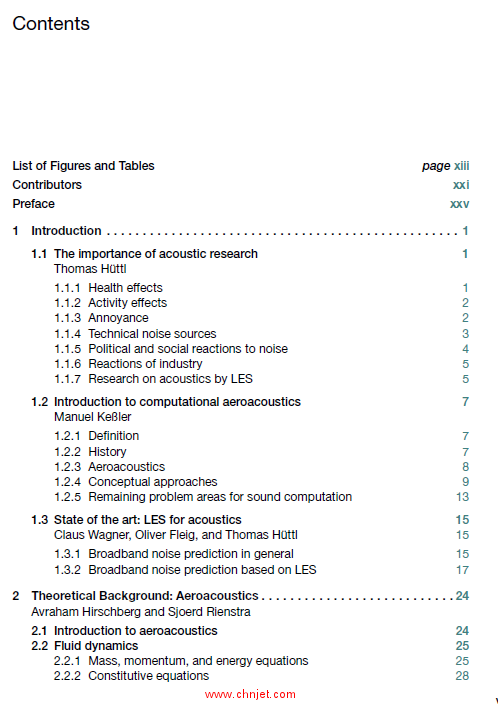马上注册,结交更多好友,享用更多功能,让你轻松玩转社区。
您需要 登录 才可以下载或查看,没有账号?立即注册

×
《Large-Eddy Simulation for Acoustics》
声学大涡模拟
编者:
CLAUS WAGNER
German Aerospace Center
THOMAS HU¨ TTL
MTU Aero Engines GmbH
PIERRE SAGAUT
Universite´ Pierre et Marie Curie
出版社:Cambridge
出版时间:2007年
《Large-Eddy Simulation for Acoustics》

《Large-Eddy Simulation for Acoustics》

《Large-Eddy Simulation for Acoustics》

《Large-Eddy Simulation for Acoustics》

目录
List of Figures and Tables page xiii
Contributors xxi
Preface xxv
1 Introduction . . . . . . . . . . . . . . . . . . . . . . . . . . . . . . . . . . . . . . . . . . . . . . . . . 1
1.1 The importance of acoustic research 1
Thomas Hu¨ ttl
1.1.1 Health effects 1
1.1.2 Activity effects 2
1.1.3 Annoyance 2
1.1.4 Technical noise sources 3
1.1.5 Political and social reactions to noise 4
1.1.6 Reactions of industry 5
1.1.7 Research on acoustics by LES 5
1.2 Introduction to computational aeroacoustics 7
Manuel Keßler
1.2.1 Definition 7
1.2.2 History 7
1.2.3 Aeroacoustics 8
1.2.4 Conceptual approaches 9
1.2.5 Remaining problem areas for sound computation 13
1.3 State of the art: LES for acoustics 15
Claus Wagner, Oliver Fleig, and Thomas Hu¨ ttl 15
1.3.1 Broadband noise prediction in general 15
1.3.2 Broadband noise prediction based on LES 17
2 Theoretical Background: Aeroacoustics . . . . . . . . . . . . . . . . . . . . . . . . . . . 24
Avraham Hirschberg and Sjoerd Rienstra
2.1 Introduction to aeroacoustics 24
2.2 Fluid dynamics 25
2.2.1 Mass, momentum, and energy equations 25
2.2.2 Constitutive equations 28
vii
viii CONTENTS
2.2.3 Approximations and alternative forms of the basic
equations 30
2.3 Free-space acoustics of a quiescent fluid 33
2.3.1 Orders of magnitude 33
2.3.2 Wave equation and sources of sound 35
2.3.3 Green’s function and integral formulation 36
2.3.4 Inverse problem and uniqueness of source 38
2.3.5 Elementary solutions of the wave equation 39
2.3.6 Acoustic energy and impedance 44
2.3.7 Free-space Green’s function 47
2.3.8 Multipole expansion 47
2.3.9 Doppler effect 49
2.3.10 Uniform mean flow, plane waves, and edge diffraction 52
2.4 Aeroacoustic analogies 55
2.4.1 Lighthill’s analogy 55
2.4.2 Curle’s formulation 59
2.4.3 Ffowcs Williams–Hawkings formulation 60
2.4.4 Choice of aeroacoustic variable 62
2.4.5 Vortex sound 65
2.5 Confined flows 68
2.5.1 Wave propagation in a duct 68
2.5.2 Low-frequency Green’s function in an infinitely long uniform duct 72
2.5.3 Low-frequency Green’s function in a duct with a discontinuity 74
2.5.4 Aeroacoustics of an open pipe termination 76
3 Theoretical Background: Large-Eddy Simulation . . . . . . . . . . . . . . . . . . . . 89
Pierre Sagaut
3.1 Introduction to large-eddy simulation 89
3.1.1 General issues 89
3.1.2 Large-eddy simulation: Underlying assumptions 90
3.2 Mathematical models and governing equations 91
3.2.1 The Navier–Stokes equations 91
3.2.2 The filtering procedure 92
3.2.3 Governing equations for LES 95
3.2.4 Extension for compressible flows 98
3.2.5 Filtering on real-life computational grids 100
3.3 Basic numerical issues in large-eddy simulation 105
3.3.1 Grid resolution requirements 105
3.3.2 Numerical error: Analysis and consequences 109
3.3.3 Time advancement 112
3.4 Subgrid-scale modeling for the incompressible case 112
3.4.1 The closure problem 112
3.4.2 Functional modeling 113
3.4.3 Structural modeling 118
3.4.4 Linear combination models, full deconvolution, and Leray’s
regularization 119
3.4.5 Extended deconvolution approach for arbitrary nonlinear terms 120
3.4.6 Multilevel closures 121
3.4.7 The dynamic procedure 121
CONTENTS ix
3.5 Extension of subgrid models for the compressible case 125
3.5.1 Background 125
3.5.2 Extension of functional models 125
3.5.3 Extension of structural models 126
3.5.4 The MILES concept for compressible flows 126
4 Use of Hybrid RANS–LES for Acoustic Source Predictions . . . . . . . . . . . .128
Paul Batten, Philippe Spalart, and Marc Terracol
4.1 Introduction to hybrid RANS–LES methods 128
4.2 Global hybrid approaches 130
4.2.1 The approach of Speziale 130
4.2.2 Detached-eddy simulation 131
4.2.3 LNS 133
4.2.4 The approach of Menter, Kunz, and Bender 138
4.2.5 Defining the filter width 140
4.2.6 Modeling the noise from unresolved scales 142
4.2.7 Synthetic reconstruction of turbulence 143
4.2.8 The NLAS approach of Batten, Goldberg,
and Chakravarthy 145
4.3 Zonal hybrid approaches 148
4.3.1 The approach of Que´me´ re´ and Sagaut 150
4.3.2 The approach of Labourasse and Sagaut 150
4.3.3 Zonal-interface boundary coupling 152
4.4 Examples using hybrid RANS–LES formulations 154
4.4.1 Flow in the wake of a car wing mirror 154
4.4.2 Unsteady flow in the slat cove of a high-lift airfoil 158
4.5 Summary of hybrid RANS–LES methods 163
5 Numerical Methods . . . . . . . . . . . . . . . . . . . . . . . . . . . . . . . . . . . . . . . . . . 167
5.1 Spatial and temporal discretization schemes 167
Tim Broeckhoven, Jan Ramboer, Sergey Smirnov, and Chris Lacor
5.1.1 Introduction to discretization schemes 167
5.1.2 Dispersion and dissipation errors 168
5.1.3 Spatial discretization schemes 170
5.1.4 Temporal discretization schemes 197
5.2 Boundary conditions for LES 201
Michael Breuer
5.2.1 Outflow boundary conditions 203
5.2.2 Inflow boundary conditions 204
5.2.3 Boundary conditions for solid walls 208
5.2.4 Far-field boundary conditions for compressible flows 214
5.2.5 Final remark for discretization schemes 215
5.3 Boundary conditions: Acoustics 216
Fang Q. Hu
5.3.1 Characteristic nonreflecting boundary condition 217
5.3.2 Radiation boundary condition 218
5.3.3 Absorbing-zone techniques 218
x CONTENTS
5.3.4 Perfectly matched layers 220
5.3.5 Summary of boundary conditions for acoustics 222
5.4 Some concepts of LES–CAA coupling 222
Wolfgang Schro¨ der and Roland Ewert
5.4.1 LES inflow boundary 225
5.4.2 Silent embedded boundaries 232
6 Applications and Results of Large-Eddy Simulations for Acoustics . . . . . 238
6.1 Plane and axisymmetric mixing layers 238
Christophe Bogey and Christophe Bailly
6.1.1 Plane mixing layer 239
6.1.2 Axisymmetric mixing layers – jets 241
6.1.3 Concluding remarks for mixing layer simulations 244
6.2 Far-field jet acoustics 245
Daniel J. Bodony and Sanjiva K. Lele
6.2.1 Introduction to jet acoustics 245
6.2.2 Numerics of jet simulations 247
6.2.3 Results for jet simulations 252
6.2.4 Future directions of jet acoustics 259
6.2.5 Conclusions for far-field jet acoustics 262
6.2.6 Acknowledgments 262
6.3 Cavity noise 262
Xavier Gloerfelt, Christophe Bogey, and Christophe Bailly
6.3.1 Introduction to cavity noise 262
6.3.2 Overview of cavity-flow simulations 263
6.3.3 Recent achievements using LES 266
6.3.4 Concluding remarks for cavity noise 272
6.4 Aeroelastic noise 272
Sandrine Vergne, Jean-Marc Auger, Fred Pe´ rie´ , Andre´ Jacques,
and Dimitri Nicolopoulos
6.4.1 Introduction to aeroelastic noise 272
6.4.2 Fluid–structure interaction 274
6.4.3 Numerical simulation 276
6.4.4 Application 278
6.4.5 Simulation model 279
6.4.6 Numerical results 283
6.4.7 Mesh influence 290
6.4.8 Conclusions for aeroelastic noise prediction 293
6.4.9 Acknowledgment 293
6.5 Trailing-edge noise 293
Roland Ewert and Eric Manoha
6.5.1 Introduction to trailing-edge noise simulation using LES 293
6.5.2 Trailing-edge noise simulation using LES and APE 296
6.5.3 Trailing-edge noise simulation using LES, Euler equations,
and the Kirchhoff integral 315
6.5.4 Unsteady pressure-field analysis 320
CONTENTS xi
6.6 Blunt bodies (cylinder, cars) 333
Franco Magagnato
6.6.1 Overview of blunt-body simulations 333
6.6.2 Circular cylinder 335
6.6.3 Car 345
6.7 Internal flows 349
Philippe Lafon, Fabien Crouzet, and Jean Paul Devos
6.7.1 Introduction to internal flows 349
6.7.2 Computation of acoustic fluctuations due to
turbulence-generated noise at low Mach number 349
6.7.3 Computation of flow acoustic coupling in low-Mach-number
ducted flows 351
6.7.4 Computation of aeroacoustic instabilities in high-Machnumber
ducted flow 354
6.7.5 Conclusions for internal flow prediction 355
6.8 Industrial aeroacoustics analyses 356
Fred Mendonc¸ a
6.8.1 Introduction to industrial aeroacoustics analyses 356
6.8.2 Preliminary considerations 357
6.8.3 A two-step CFD modeling process (steady-state and transient) 358
6.8.4 Postprocessing through acoustic coupling 370
6.8.5 Conclusions for industrial aeroacoustics analyses 376
6.8.6 Acknowledgments 376
7 Conclusions . . . . . . . . . . . . . . . . . . . . . . . . . . . . . . . . . . . . . . . . . . . . . . . 378
Claus Wagner, Pierre Sagaut, and Thomas Hu¨ ttl
7.1 Governing equations and acoustic analogies 378
7.2 Numerical errors 384
7.3 Initial and boundary conditions 385
7.4 Examples 386
Appendix A. Nomenclature 389
Appendix B. Abbreviations 391
References 395
Index 429
专业书籍
下载地址:(回复后可见)
|
![]()